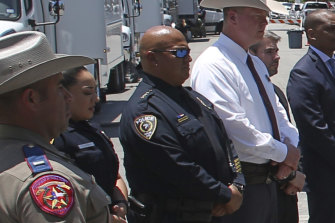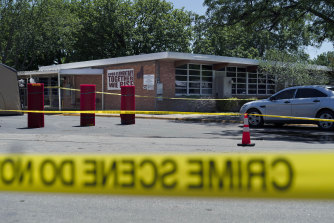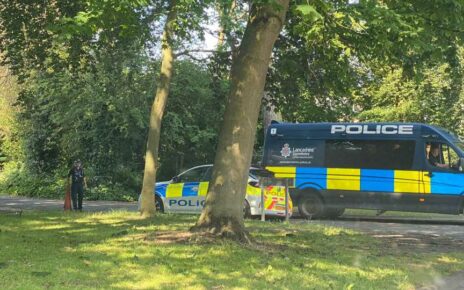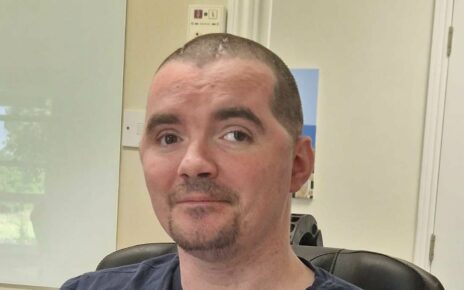Austin: Heavily armed officers delayed confronting a gunman in Uvalde, Texas, for more than an hour despite supervisors at the scene being told that some trapped with him in two elementary school classrooms needed medical treatment, a new review of video footage and other investigative material shows.
Instead, the documents show, they waited for protective equipment to lower the risk to law enforcement officers.
The school district police chief, who was leading the response to the May 24 shooting, appeared to be agonising over the length of time it was taking to secure the shields that would help protect officers and to find a key for the classroom doors, according to law enforcement documents and video gathered as part of the investigation reviewed by The New York Times.
Uvalde School Police Chief Pete Arredondo, third from left, stands during a news conference outside of the Robb Elementary school in Uvalde, Texas.Credit:AP
The chief, Pete Arredondo, and others at the scene became aware that not everyone inside the classrooms was dead, the documents showed, including a report from a school district police officer whose wife, a teacher, had spoken to him by phone from one of the classrooms to say she had been shot.
More than a dozen of the 33 children and three teachers originally in the two classrooms remained alive during the 1 hour and 17 minutes from the time the shooting began inside the classrooms to when four officers made entry, law enforcement investigators have concluded.
Robb Elementary School after a mass shooting in Uvalde, Texas.Credit:AP
“People are going to ask why we’re taking so long,” a man who investigators believe to be Arredondo could be heard saying, according to a transcript of officers’ body camera footage. “We’re trying to preserve the rest of the life.”
Investigators have been working to determine whether any of those who died could have been saved, according to an official with knowledge of the effort. But there is no question that some of the victims were still alive and in desperate need of medical attention.
One teacher died in an ambulance. Three children died at nearby hospitals, according to the documents.
Supervisors at the scene at some point became aware that there were people inside the classrooms who needed saving.
“We think there are some injuries in there,” the man believed to be Arredondo said several minutes before the breach, according to the transcript.
“And so you know what we did, we cleared off the rest of the building so we wouldn’t have any more, besides what’s already in there, obviously.”
But even with additional documents and video, much about the chaotic scene remained unclear, including precisely when Arredondo and other senior officers became aware of injuries inside the classrooms. It is not known whether Arredondo or other officers inside the school learned of the 911 calls from a child inside the classrooms.
Among the revelations in the documents: The gunman, Salvador Ramos, had a “hellfire” trigger device meant to allow a semi-automatic AR-15-style rifle to be fired more like an automatic weapon; some of the officers who first arrived at the school had more firepower than previously known; and Arredondo learned the gunman’s identity while inside the school and attempted in vain to communicate with him.
But with two officers who initially approached the door shot at and grazed, Arredondo appeared to have decided that quickly breaching the classrooms without protection would have led to officers possibly being killed. He focused instead on getting other children out of the school while waiting for additional equipment.
The response by the police at Robb Elementary School is now the subject of overlapping investigations by the Texas state police and the US Justice Department.
Now, more than two weeks after the gunman killed 19 children and two teachers, a clearer picture of the timeline of events and the police response has emerged.
A cascade of failures took place at the school: the local police radio system, later tests showed, did not function properly inside the building; classroom doors could not be quickly locked in an emergency; and after an initial burst of shooting from the gunman, no police officer went near the door again for more than 40 minutes, instead hanging back.
According to the documents, Arredondo, who had earlier focused on evacuating other classrooms, began to discuss breaching the classrooms about an hour after the gunfire started inside the school at 11.33am. He did so after several shots could be heard inside the classrooms around 12.21pm, video footage showed.
By that point, officers in and around the school had been growing increasingly impatient. “If there’s kids in there, we need to go in there,” one officer could be heard saying, according to the documents. Another responded, “Whoever is in charge will determine that.”
A team made up of specially trained Border Patrol agents and a sheriff’s deputy finally went in after the gunman and killed him at 12.50pm.
The lack of clear orders underscored the chaos and poor communication in a response that included dozens of state and local police officers, sheriff’s deputies and federal agents from the Border Patrol, many of whom lived or worked nearby.
And most of the officers arrived with radios that did not function well inside the school building, according to the investigators’ review.
Arredondo arrived at the scene without any radio at all, and used a cellphone for some communications. It was not clear if he ever received a radio.
Arredondo did not respond to several requests for comment.
The investigative documents provide additional details about the gunman and the weaponry he acquired.
Before entering the school, he had amassed an arsenal that included two AR-15-style rifles, accessories and hundreds of rounds of ammunition, according to the documents. He spent more than $US6000.
Among the purchases was the “hellfire” trigger device, but the gunman did not appear to have succeeded in using it during the attack, according to an analysis by the federal Bureau of Alcohol, Tobacco, Firearms and Explosives.
After the gunman entered the school, surveillance footage showed him walking through nearly empty blue and green hallways. He did not appear to fire until he got to Room 111 and Room 112.
It was not clear why he stopped there. He had been a student at the school as a child, and his time there may have overlapped with at least one of the teachers, Irma Garcia, who taught in Room 112, according to the documents.
Arredondo was among the first officers to enter the school and approach the classrooms where the gunman was.
Two Uvalde Police Department officers, a lieutenant and a sergeant, were shot and suffered grazing wounds after they tried to peer through a window in one of the classroom doors, the surveillance footage showed. The entire group of officers who had arrived by then sought cover down the hallway.
This article originally appeared in The New York Times.
Most Viewed in World
From our partners
Source: Read Full Article



